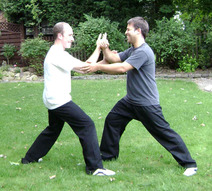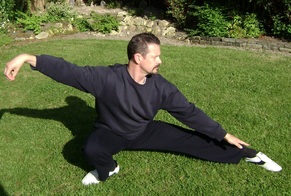Tai Chi Chuan
All over the world, people are beginning to recognise the health benefits of this ancient Martial Arts discipline. Older people are being advised to practice it to reduce their likelihood of falls, improve their balance, posture, co-ordination and breathing, lower their blood pressure and even strengthen their bones and joints to help to prevent arthritis and osteoporosis. Other benefits include calmness, mindfulness, increased confidence, happiness and self-esteem. And all of this is quite apart from the obvious benefits of learning one of the oldest and most effective self-protection systems in the world.
-----------------------------------------------------------------------------------------------------------------------------------------------------------------------------------
Free Gift from us

Download your Free 18-page eBook covering pretty much everything you need to know to get you started on your Tai Chi journey of discovery, including:
- What Tai Chi is
- Why people do it
- What to wear
- What to expect in a Tai Chi class
- An illustrated guide to the basic principles that will help to give you a head start in your first few lessons
- And much, much more
Just click on the link (orange letters) to download your free guide as a PDF which your can read, save to your hard drive or print off to add to your collection.
Your Tai Chi Companion Part 1 - Getting Started
Happy exploring!
(There are more free gifts further down this page and also on the Qigong Page!)
If you are looking for a list of movements in some of the main forms we teach, click this link: Tai Chi Forms
Who can do Tai Chi?

Everyone!! Tai Chi is suitable for most individuals of any age but if you have any medical problems which you feel may interfere with your ability to do Tai Chi, or if you are concerned about how Tai Chi might affect you, please discuss these concerns with your instructor (and your GP or Physiotherapist, if appropriate).
If you are unable to walk, you may still be able to benefit from the upper body movements of Tai Chi while sitting in a chair, armchair or wheelchair. We have devised stationary versions of some of the Tai Chi sequences so that people who are unable to stand can still potentially attain mastery of the internal principles of Tai Chi Chuan.
Pictured here are our dear friends, the East Leeds class of 2004. Several of them went on to qualify as instructors. (Can you spot them?)
If you are unable to walk, you may still be able to benefit from the upper body movements of Tai Chi while sitting in a chair, armchair or wheelchair. We have devised stationary versions of some of the Tai Chi sequences so that people who are unable to stand can still potentially attain mastery of the internal principles of Tai Chi Chuan.
Pictured here are our dear friends, the East Leeds class of 2004. Several of them went on to qualify as instructors. (Can you spot them?)
Tai Chi Hand Forms

At Yiheyuan, we teach several different sequences. Beginners usually start with the Cheng Man Ching 37 posture short form.
Click on this link to see a you tube video clip of some of our students enjoying
the Cheng Man Ching Form last summer at "Tai Chi in the Park".
Click on this link to see a you tube video clip of some of our students enjoying
the Cheng Man Ching Form last summer at "Tai Chi in the Park".
Tai Chi Push Hands

Though it is not compulsory, some students like to explore the self-protection aspects of Tai Chi Chuan, beginning with a series of push hands drills with a partner.
Here is a You Tube clip showing a comprehensive selection of basic drills in Tai Chi Pushing Hands
Push Hands trains sensitivity and self-protection skills.
Here is a You Tube clip showing a comprehensive selection of basic drills in Tai Chi Pushing Hands
Push Hands trains sensitivity and self-protection skills.
Competitions

A few of our students who have trained in Tai Chi to an advanced level, test their skills in National and International Competitions.
Here are Ben Morris (Orange Belt) and Mike Abosh (sitting on the floor) in Sweden in 2008, where they both gained Gold medals in the European Championships.
See more competition results on the Yiheyuan News page
Here are Ben Morris (Orange Belt) and Mike Abosh (sitting on the floor) in Sweden in 2008, where they both gained Gold medals in the European Championships.
See more competition results on the Yiheyuan News page
More Free Gifts for You

Free downloads:
Verbal instructions for the whole 108 movement Yang Style Long form
Lasting 13 minutes, this MP3 is an audio resource providing verbal prompts to help you to remember the order of the movements in the sequence while you practice. Pop it on your phone or MP3 player and listen though headphones while you enjoy your Tai Chi outdoors.
And, at your request, you can also now download the Cheng Man Ching form as MP3 files. You even have a choice of listening to the names of the movements only or a more detailed version with extra instructions along the way.
Cheng Man Ching Form - Movements Only
Cheng Man Ching Form - Movements and Instructions
If you already have some Tai Chi experience and would like to review your progress and explore ways in which you can enrich your experience of the art, you might like to download free 44-page guide
Your Tai Chi Companion Part 2 - Moving On
For more information
For more information about Tai Chi Chuan, you might like to click this link to go to:
www.realtaichiUK.com
Subjects discussed include:
- What Tai Chi is and What it is not.
- Benefits of Tai Chi.
- The Tai Chi Principles and the Tai Chi classics.
- Tai Chi Myths exploded.
- Tai Chi Chuan as a fighting art.
- Lists of the order of the movements of several Tai Chi sequences.
Retun Home
